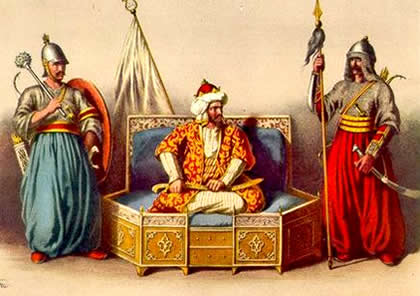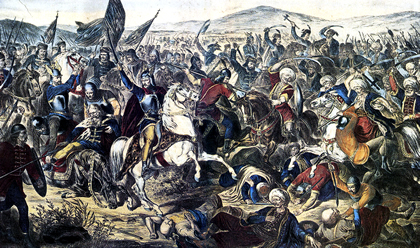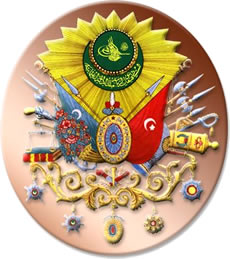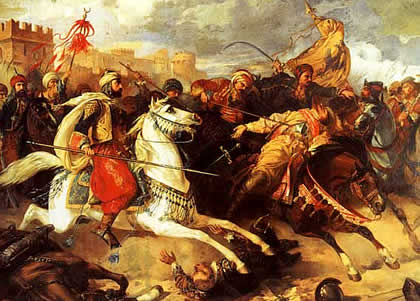World History
In the 13th century a nomadic Turkish tribesman named Ertogrul established control over large parts of northwest Anatolia. The Ottoman Empire took its name from his son Osman (r. 1280–1324); Ottoman was an Italian corruption of Osmanli.
As the Seljuk dynasty and other Turkish dynasties, the Ottoman Empire relied on ghazi warriors as the foundation of its military power. The Ghazi warriors were an egalitarian society in which leadership was earned through bravery and feats in battle.
They practiced a code of conduct (futuwwa) analogous to the code of chivalry among western medieval knights. Converts to Sunni Islam, the Ottomans viewed themselves as protectors of Islam.
Osman married the daughter of a Sufi shaykh who was the master of one of the numerous Sufiorders that had been established in Asia Minor. Sufi shaykhs often became the spiritual leaders in Ottoman society.
Like all early Ottoman leaders Osman and his son Orhan (r. 1324–c. 1359) were able military leaders who personally led their troops into battle. Both expanded Ottoman territories and, with the conquest of Gallipoli, Orhan extended Ottoman lands into Europe.
Murad I (r. 1360–89) took the title of sultan and continued Ottoman expansion into the Balkans and Anatolia, taking Adrianople and Ankara. Ottoman victories further diminished the territories under the Byzantine Empire. The Ottoman victory at the Battle of Kosovo in 1389 was a major defeat for the Serbians and began a long period of Ottoman domination over most of the Balkans.
The first 10 Ottoman sultans were men of strong personalities with remarkable abilities. The position of sultan was the only role reserved for the heirs of the house of Osman; otherwise, the Ottoman Empire fostered remarkable upward mobility for its conquered peoples, who could, and often did, rise to the highest military, political, and economic positions within the empire.
Following Muslim precepts the Ottomans were also tolerant of religious minorities and often intermarried with the different religious and ethnic groups within the empire. However a Turkish-speaking elite dominated the ruling class.
In Europe the early Ottomans ruled from Edirne (Adrianople), while Bursa served as the capital of the empire. The relative stability of Ottoman rule attracted scholars and merchants to Bursa. Merchants and skilled craftsmen formed guilds of ahki or cooperatives that contributed to the economic prosperity of the empire.
The control of major trade routes also financially benefited the Ottomans. Charitable foundations (awqaf) provided extensive social services. An Islamic legal system with trained qadis (judges) provided an overall judicial framework for the empire.
Under Murad I landownership was registered and a more centralized government emerged. The grand vizier served as the chief minister and key administrator after the sultan. Although the Turkish tribal families resented the loss of their traditional autonomy, the Ottoman army and administration were strong enough to prevent major rebellions.
Bayezid I (r. 1389–1402) became sultan after the death of his father, Murad I, at the Battle of Kosovo. To ensure his succession Bayezid had his brother killed; subsequent Ottoman sultans often sanctioned fratricide or the imprisonment of family members to prevent rebellions or divisions over succession. Although Bayezid won a number of battles in the Balkans and Anatolia, he also adopted a number of Byzantine or Balkan social customs.
Under his sultanate a lavish royal court emerged. Ottoman sultans frequently married non-Turkish women. The harem, composed of the sultan’s mother, wives, former wives, and concubines, grew in size and importance. The mothers and wives of the sultans became powers in their own right and frequently intrigued to secure the succession of their favorite sons to the sultanate.
Timurlane (Tamerlane) stopped Ottoman territorial expansion. At the Battle of Ankara in 1402 he captured Bayezid and subsequently had him killed. Timurlane dismembered Ottoman territory, dividing it among separate rulers.
However, following a struggle with his brothers, Mehmed I (r. 1413–21) presided over a remarkable revival of the empire, which emerged stronger and more powerful than previously. Murad II (r. 1421–44; 1446–51) resumed the expansion and control over the Balkans and moved into Hungary. Although he besieged Constantinople he failed to take the city.
The victory in 1444 at the Battle of Varna marked the consolidation of Ottoman rule over the Balkans. Within a decade the Ottomans would achieve a final victory over the failing Byzantine Empire.
- Bayezid I
Bayezid I Bayezid I was declared sultan following the death of Sultan Murad on the battlefield at Kosovo in 1389. To ensure his uncontested succession to the sultanate, Bayezid had his brother Yakub assassinated; subsequently the practice of fratricide...
- Battle Of Kosovo (1389)
Battle of Kosovo (1389) The Battle of Kosovo was a turning point in Ottoman control over the Balkans and a major defeat for the Serbs. As the Muslim Ottoman army moved deep inside Balkan territory, The Serbian ruler Lazar I, with the solid backing of...
- Mehmed Ii - Ottoman Sultan
Mehmed II - Ottoman Sultan Mehmed II (reigned 1444–46; 1451–81) was only 12 years old when his father, Murad II, abdicated to pursue a life of religious contemplation (following Sufi or Islamic mysticism) and appointed him sultan in 1444....
- The Siege Of Constantinople In 1453
The Siege of Constantinople in 1453 - The fall of Constantinople marked the end of the Byzantine Empire and the beginning of the Ottoman; an online collection of primary sources and articles. From the site: One of the most important events in world history,...
- The Ottoman Khilafa
The Ottoman Khilafa - An account of the Ottoman Caliphate, from its founding in 1281, through the glories of empire, decline in the 19th century, and collapse after World War I. From the site: The founder of the Ottoman Empire, Osman Gazi (or, as he is...
World History
Ottoman Empire: 1299–1453
 |
| Ottoman Empire |
In the 13th century a nomadic Turkish tribesman named Ertogrul established control over large parts of northwest Anatolia. The Ottoman Empire took its name from his son Osman (r. 1280–1324); Ottoman was an Italian corruption of Osmanli.
As the Seljuk dynasty and other Turkish dynasties, the Ottoman Empire relied on ghazi warriors as the foundation of its military power. The Ghazi warriors were an egalitarian society in which leadership was earned through bravery and feats in battle.
They practiced a code of conduct (futuwwa) analogous to the code of chivalry among western medieval knights. Converts to Sunni Islam, the Ottomans viewed themselves as protectors of Islam.
  |   |
Osman married the daughter of a Sufi shaykh who was the master of one of the numerous Sufiorders that had been established in Asia Minor. Sufi shaykhs often became the spiritual leaders in Ottoman society.
Like all early Ottoman leaders Osman and his son Orhan (r. 1324–c. 1359) were able military leaders who personally led their troops into battle. Both expanded Ottoman territories and, with the conquest of Gallipoli, Orhan extended Ottoman lands into Europe.
Murad I (r. 1360–89) took the title of sultan and continued Ottoman expansion into the Balkans and Anatolia, taking Adrianople and Ankara. Ottoman victories further diminished the territories under the Byzantine Empire. The Ottoman victory at the Battle of Kosovo in 1389 was a major defeat for the Serbians and began a long period of Ottoman domination over most of the Balkans.
The first 10 Ottoman sultans were men of strong personalities with remarkable abilities. The position of sultan was the only role reserved for the heirs of the house of Osman; otherwise, the Ottoman Empire fostered remarkable upward mobility for its conquered peoples, who could, and often did, rise to the highest military, political, and economic positions within the empire.
 |
| Battle of Kosovo |
Following Muslim precepts the Ottomans were also tolerant of religious minorities and often intermarried with the different religious and ethnic groups within the empire. However a Turkish-speaking elite dominated the ruling class.
In Europe the early Ottomans ruled from Edirne (Adrianople), while Bursa served as the capital of the empire. The relative stability of Ottoman rule attracted scholars and merchants to Bursa. Merchants and skilled craftsmen formed guilds of ahki or cooperatives that contributed to the economic prosperity of the empire.
The control of major trade routes also financially benefited the Ottomans. Charitable foundations (awqaf) provided extensive social services. An Islamic legal system with trained qadis (judges) provided an overall judicial framework for the empire.
 |
| Ottoman symbol |
Bayezid I (r. 1389–1402) became sultan after the death of his father, Murad I, at the Battle of Kosovo. To ensure his succession Bayezid had his brother killed; subsequent Ottoman sultans often sanctioned fratricide or the imprisonment of family members to prevent rebellions or divisions over succession. Although Bayezid won a number of battles in the Balkans and Anatolia, he also adopted a number of Byzantine or Balkan social customs.
Under his sultanate a lavish royal court emerged. Ottoman sultans frequently married non-Turkish women. The harem, composed of the sultan’s mother, wives, former wives, and concubines, grew in size and importance. The mothers and wives of the sultans became powers in their own right and frequently intrigued to secure the succession of their favorite sons to the sultanate.
Timurlane (Tamerlane) stopped Ottoman territorial expansion. At the Battle of Ankara in 1402 he captured Bayezid and subsequently had him killed. Timurlane dismembered Ottoman territory, dividing it among separate rulers.
 |
| Battle of Varna |
However, following a struggle with his brothers, Mehmed I (r. 1413–21) presided over a remarkable revival of the empire, which emerged stronger and more powerful than previously. Murad II (r. 1421–44; 1446–51) resumed the expansion and control over the Balkans and moved into Hungary. Although he besieged Constantinople he failed to take the city.
The victory in 1444 at the Battle of Varna marked the consolidation of Ottoman rule over the Balkans. Within a decade the Ottomans would achieve a final victory over the failing Byzantine Empire.
- Bayezid I
Bayezid I Bayezid I was declared sultan following the death of Sultan Murad on the battlefield at Kosovo in 1389. To ensure his uncontested succession to the sultanate, Bayezid had his brother Yakub assassinated; subsequently the practice of fratricide...
- Battle Of Kosovo (1389)
Battle of Kosovo (1389) The Battle of Kosovo was a turning point in Ottoman control over the Balkans and a major defeat for the Serbs. As the Muslim Ottoman army moved deep inside Balkan territory, The Serbian ruler Lazar I, with the solid backing of...
- Mehmed Ii - Ottoman Sultan
Mehmed II - Ottoman Sultan Mehmed II (reigned 1444–46; 1451–81) was only 12 years old when his father, Murad II, abdicated to pursue a life of religious contemplation (following Sufi or Islamic mysticism) and appointed him sultan in 1444....
- The Siege Of Constantinople In 1453
The Siege of Constantinople in 1453 - The fall of Constantinople marked the end of the Byzantine Empire and the beginning of the Ottoman; an online collection of primary sources and articles. From the site: One of the most important events in world history,...
- The Ottoman Khilafa
The Ottoman Khilafa - An account of the Ottoman Caliphate, from its founding in 1281, through the glories of empire, decline in the 19th century, and collapse after World War I. From the site: The founder of the Ottoman Empire, Osman Gazi (or, as he is...
